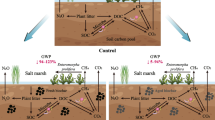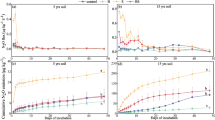Abstract
Microcosms were set up with a PAHs-contaminated soil using biostimulation (addition of ground corn cob) and bioaugmentation (inoculated with Monilinia sp. W5-2). Degradation of polycyclic aromatic hydrocarbons and microbial community were examined at the end of incubation period. After 30 days, bioaugmented microcosms showed a 35 ± 0% decrease in total PAHs, while biostimulated and control microcosms showed 16 ± 9% and 3 ± 0% decrease in total PAHs, respectively. Bioaugmented microcosms also revealed 70 ± 8% and 72 ± 2% decreases in benzo[a]pyrene and anthracene, respectively, while the values for biostimulated and control microcosms were much lower. Detoxification of soils in bioaugmented microcosms was confirmed by genetic toxicity assay, suggesting important role of fungal remediation. Molecular fingerprint profiles and selective enumeration showed biostimulation with ground corn cob increased both number and abundance of indigenous aromatic hydrocarbons degraders and changed microbial community composition in soil, which is beneficial to natural attenuation of PAHs. At the same time, bioaugmentation with Monilinia strain W5-2 imposed negligible effect on indigenous microbial community. This study suggests that fungal remediation is promising in eliminating PAHs, especially the part of recalcitrant and highly toxic benzo[a]pyrene, in contaminated soil. It is also the first description of soil bioremediation with Monilinia sp.



Similar content being viewed by others
References
Altschul SF, Madden TL, Schäffer AA, Zhang J, Zhang Z, Miller W, Lipman DJ (1997) Gapped BLAST and PSI-BLAST: a new generation of protein database search programs. Nucleic Acids Res 25:3389–3402
Andersson BE, Lundstedt S, Tornberg K, Schnurer Y, Oberg LG, Mattiasson B (2003) Incomplete degradation of polycyclic aromatic hydrocarbons in soil inoculated with wood-rotting fungi and their effect on the indigenous soil bacteria. Environ Toxicol Chem 22:1238–1243
Andersson BE, Tornberg K, Henrysson T, Olsson S (2001) Three-dimentional outgrowth of a wood-rotting fungus added to a contaminated soil from a former gasworks site. Biores Technol 78:37–45
Barnforth SM, Singleton I (2005) Bioremediation of polycyclic aromatic hydrocarbons: current knowledge and future directions. J Chem Technol Biotechnol 80:723–736
Bennet JW, Wunch KG, Faison BD (2002) Use of fungi biodegradation. In: Hurst CJ (eds) Manual of environmental microbiology. ASM Press, Washington, D.C
Bogan BW, Lamar RT, Burgos WD, Tien M (1999) Extent of humification of anthracene, fluoranthene, and benzo[alpha]pyrene by Pleurotus ostreatus during growth in PAH-contaminated soils. Letters in Applied Microbiology 28:250–254
Canet R, Birnstingl JG, Malcolm DG, Lopez-Real JM, Beck AJ (2001) Biodegradation of polycyclic aromatic hydrocarbons (PAHs) by native microflora and combinations of white-rot fungi in a coal-tar contaminated soil. Biores Technol 76:113–117
CCME (2004) Canadian soil quality guidelines for the protection of environmental and human health: Summary tables. Updated. CCME, Winnipeg
Cerniglia CE (1997) Fungal metabolism of polycyclic aromatic hydrocarbons: past, present and future applications in bioremediation. J Ind Microbiol Biotechnol 19:324–333
Chang S-H, Devinny JS (2000) Bioaugmentation for soil bioremediation. In: Wise DL, Trantolo DJ, Cichon EJ, Inyang HI, Stottmeister U (eds) Bioremediation of contaminated soils. Marcel Dekker Inc., New York
Coll PM, Fernandez-Abalos JM, Villanueva JR, Santamaria R, Perez P (1993) Purification and characterization of a phenoloxidase (laccase) from the lignin-degrading basidiomycete PM1 (CECT 2971). Appl Environ Microbiol 59:2607–2613
Collins PJ, Kotterman MJJ, Field JA, Dobson ADW (1996) Oxidation of anthracene and benzo[a]pyrene by laccases from Trametes versicolor. Appl Environ Microbiol 62:4563–4567
Corgie SC, Fons F, Beguiristain T, Leyval C (2006) Biodegradation of phenanthrene, spatial distribution of bacterial populations and dioxygenase expression in the mycorrhizosphere of Lolium perenne inoculated with Glomus mosseae. Mycorrhiza 16:207–212
D’Annibale A, Rosetto F, Leonardi V, Federici F, Petruccioli M (2006) Role of autochthonous filamentous fungi in bioremediation of a soil historically contaminated with aromatic hydrocarbons. Appl Environ Microbiol 72:28–36
Dekker RFH (1980) Induction and characterization of a cellobiose dehydrogenase produced by a species of Monilia. J Gen Microbiol 120:309–316
Dilly O, Bloem J, Vos A, Munch JC (2004) Bacterial diversity in agricultural soils during litter decomposition. Appl Environ Microbiol 70:468–474
Ehrlichmann H, Dott W, Eisentraeger A (2000) Assessment of the water-extractable genotoxic potential of soil samples from contaminated sites. Ecotoxicol Environ Safety 46:73–80
Eisentraeger A, Hund-Rinke K, Roembke J (2005) Assessment of ecotoxicity of contaminated soil using bioassays. In: Margesin R, Schinner F (eds) Manual for soil analysis—monitoring and assessing soil bioremediation. Springer, Berlin
Field JA, de Jong E, Feijoo Costa G, de Bont JA (1992) Biodegradation of polycyclic aromatic hydrocarbons by new isolates of white rot fungi. Appl Environ Microbiol 58:2219–2226
Gramss G, Voigt KD, Kirsche B (1999) Degradation of polycyclic aromatic hydrocarbons with three to seven aromatic rings by higher fungi in sterile and unsterile soils. Biodegradation 10:51–62
ISO (2000) ISO 13829:2000(E) Water quality—Determination of the genotoxicity of water and waste water using the umu-test. ISO, Geneva
Johnsen AR, Wick LY, Harms H (2005) Principles of microbial PAH-degradation in soil. Environ Pollut 133:71–84
Juhasz AL, Naidu R (2000) Bioremediation of high molecular weight polycyclic aromatic hydrocarbons: a review of the microbial degradation of benzo[a]pyrene. Int Biodeterio Biodeg 45:57–88
Kohlmeier S, Smits THM, Ford RM, Keel C, Harms H, Wick LY (2005) Taking the fungal highway: mobilization of pollutant-degrading bacteria by fungi. Environ Sci Technol 39:4640–4646
McErlean C, Marchant R, Banat IM (2006) An evaluation of soil colonisation potential of selected fungi and their production of ligninolytic enzymes for use in soil bioremediation applications. Antonie Van Leeuwenhoek Int. J Gen Mol Microbiol 90:147–158
Muyzer G, de Waal EC, Uitterlinden AG (1993) Profiling of complex microbial populations by denaturing gradient gel electrophoresis analysis of polymerase chain reaction-amplified genes coding for 16S rRNA. Appl Environ Microbiol 59:695–700
NIST (2006) Chemistry WebBook. http://webbook.nist.gov/chemistry/ie-ser.html. Cited 30 Oct 2006
Novotny C, Erbanova P, Sasek V, Kubatova A, Cajthaml T, Lang E, Krahl J, Zadrazil F (1999) Extracellular oxidative enzyme production and PAH removal in soil by exploratory mycelium of white rot fungi. Biodegradation 10:159–168
Pickard MA, Roman R, Tinoco R, Vazquez-Duhalt R (1999) Polycyclic aromatic hydrocarbon metabolism by white rot fungi and oxidation by Coriolopsis gallica UAMH 8260 laccase. Appl Environ Microbiol 65:3805–3809
Ping LF, Luo YM, Zhang HB, Li QB, Wu LH (2007) Distribution of polycyclic aromatic hydrocarbons in thirty typical soil profiles in the Yangtze River Delta region, east China. Environ. Pollut 147:358–365
Plaza G, Nalecz-Jawecki G, Ulfig K, Brigmon RL (2005) Assessment of genotoxic activity of petroleum hydrocarbon-bioremediated soil. Ecotoxicol Environ Saf 62:415–420
Potin O, Rafin C, Veignie E (2004) Bioremediation of an aged polycyclic aromatic hydrocarbons (PAHs)-contaminated soil by filamentous fungi isolated from the soil. Int Biodeterior Biodeg 54:45–52
Sigler WV, Turco RF (2002) The impact of chlorothalonil aplication on soil bacterial and fungal populations as assessed by denaturing gradient gel electrophoresis. Appl Soil Ecol 21:107–118
Steffen KT, Hatakka A, Hofrichter M (2002) Removal and mineralization of polycyclic aromatic hydrocarbons by litter-decomposing basidiomycetous fungi. Appl Microbiol Biotechnol 60:212–217
Thorn G (1997) The fungi in soil. In: van Elsas JD, Trevors JT, Wellington EMH (eds) Modern soil microbiology. Marcel Dekker Inc., New York
Tortella GR, Diez MC (2005) Fungal diversity and use in decomposition of environmental pollutants. Crit Rev Microbiol 31:197–212
Wei JC (1979) Manual for Fungi identification. Shanghai Sci & Tech Press, Shanghai
Wilms R, Kopke B, Sass H, Chang TS, Cypionka H, Engelen B (2006) Deep biosphere-related bacteria within the subsurface of tidal flat sediments. Environ Microbiol 8:709–719
Wrenn BA, Venosa AD (1996) Selective enumeration of aromatic and aliphatic hydrocarbon degrading bacteria by a most-probable-number procedure. Can J Microbiol 42:252–258
Acknowledgments
This research was funded by grants from Ministry of Science and Technology of the People’s Republic of China (2002CB410809) and National Natural Science Foundation of China (40432005). We thank Dr. Y. Oda, Osaka Prefectural Institute of Public Health (Osaka, Japan) for kindly supplying S. typhimurium NM2009. We also thank Prof. Yunlong Yu, Zhejiang University (Hangzhou, China) for help in identifying fungus W5-2.
Author information
Authors and Affiliations
Corresponding author
Rights and permissions
About this article
Cite this article
Wu, Y., Luo, Y., Zou, D. et al. Bioremediation of polycyclic aromatic hydrocarbons contaminated soil with Monilinia sp.: degradation and microbial community analysis. Biodegradation 19, 247–257 (2008). https://doi.org/10.1007/s10532-007-9131-9
Received:
Accepted:
Published:
Issue Date:
DOI: https://doi.org/10.1007/s10532-007-9131-9




